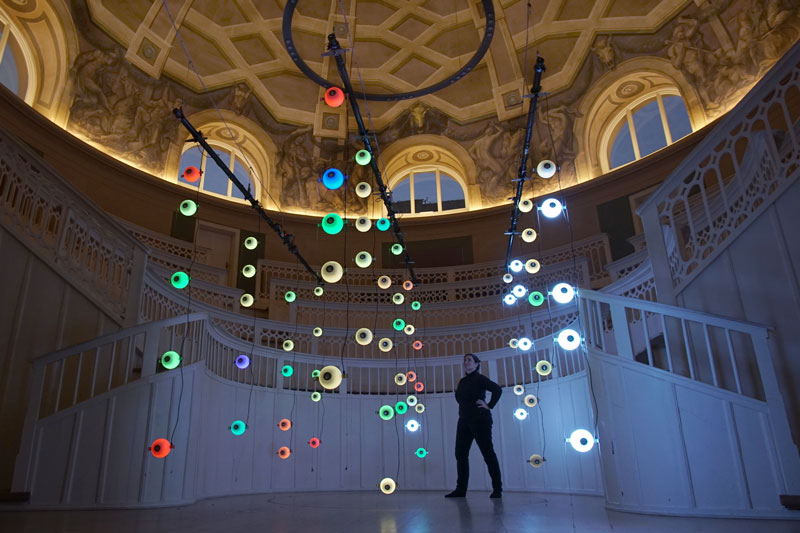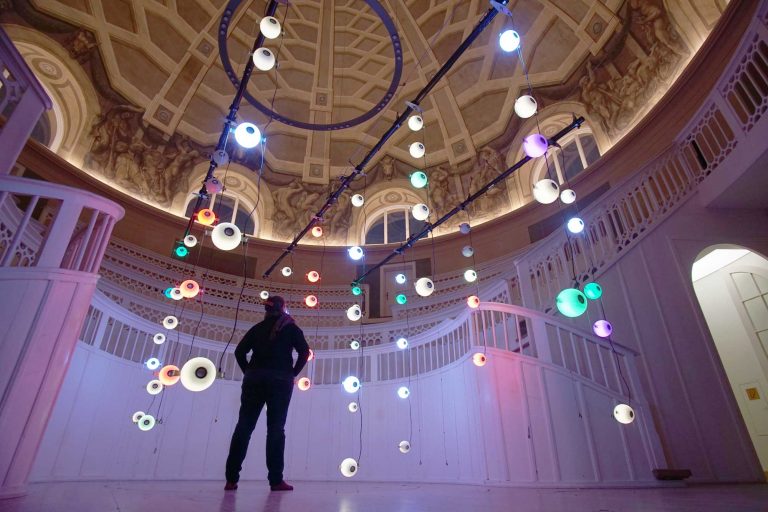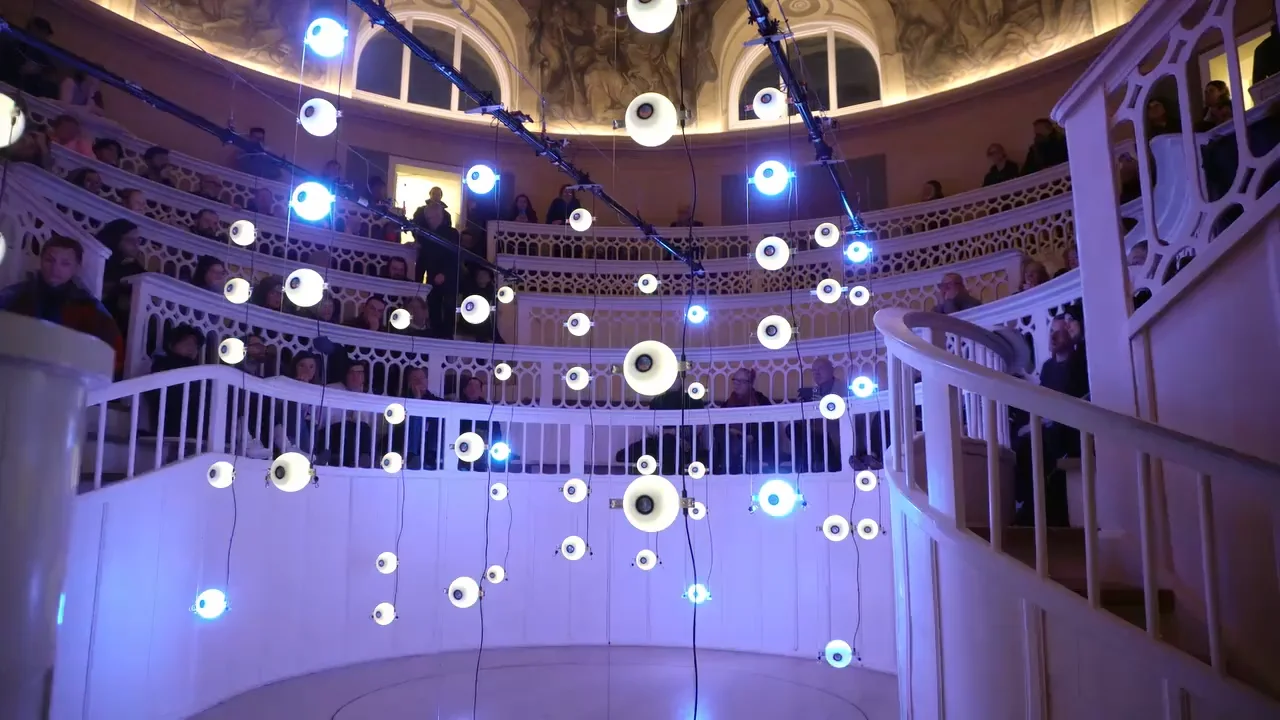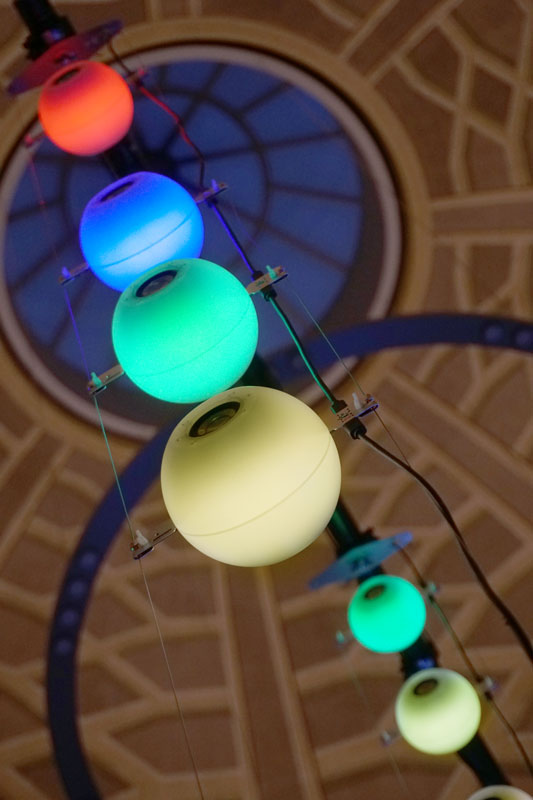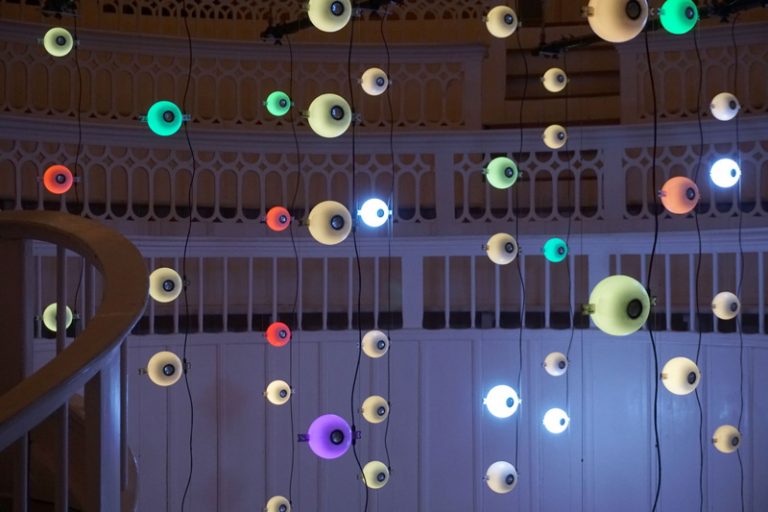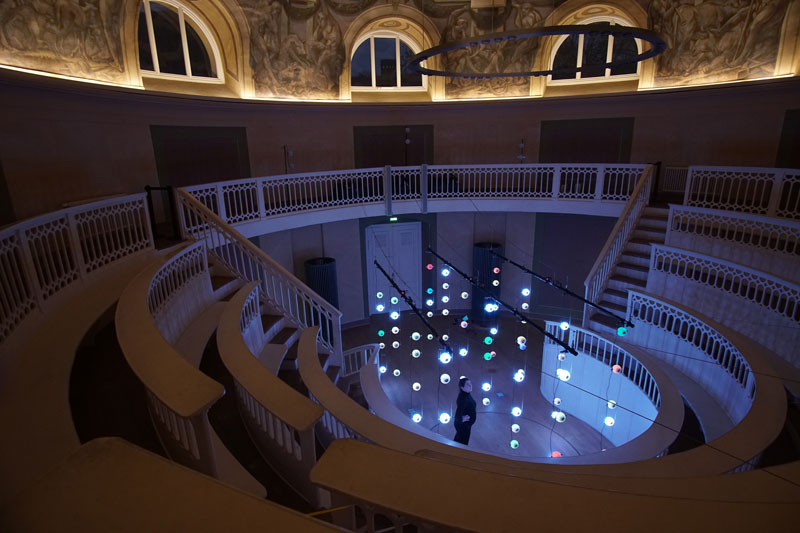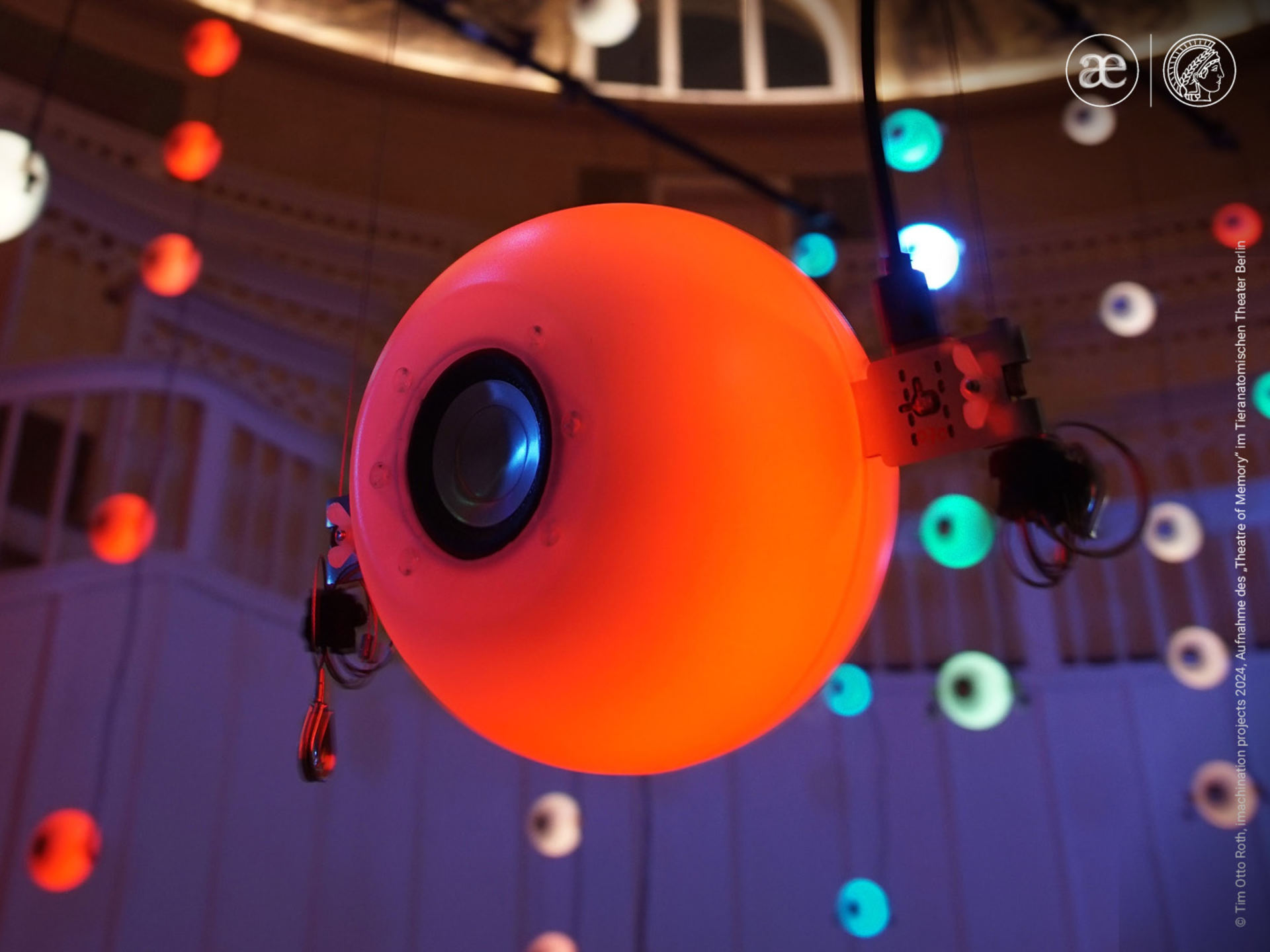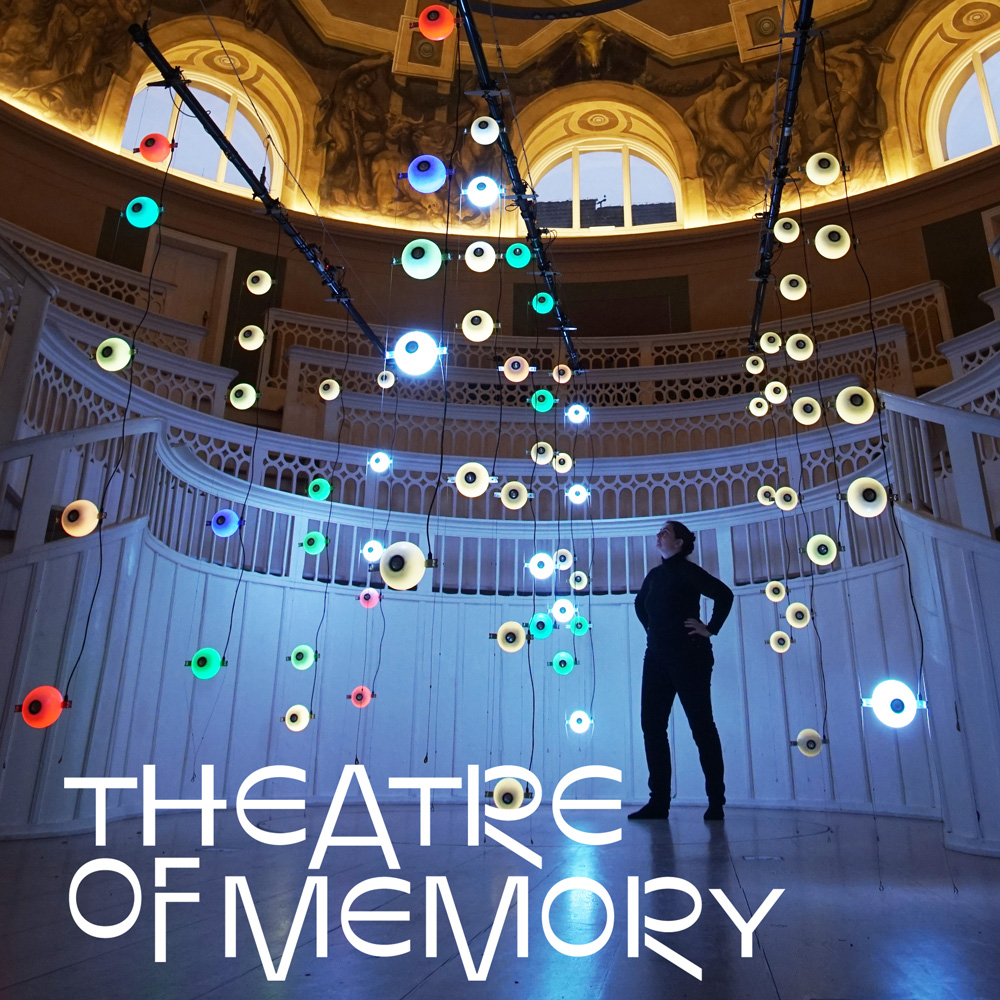+ WHAT?
Exploring memory and cognition through immersive sound.
+ HOW?
Dynamic networks of “audio neurons” shaping participatory experiences.
Since antiquity, memory has often been imagined as a theatre where perceptions, thoughts, and life episodes are staged. Theatre of Memory transfers this metaphor into an immersive music-theatrical installation. Presented first at the Tieranatomisches Theater in Berlin (January 2024), and later at the Max Planck Institute for Empirical Aesthetics in Frankfurt (February 2024), the project transforms architectural spaces into neuronal sound theatres.
At its core are luminous loudspeaker sculptures, or “audio neurons,” which excite and inhibit one another through characteristic sine tones. Their dynamically shifting tone sequences, rhythmic bursts, and color pulsations are not pre-composed but self-organized in real time. This creates a living acoustic organism in which music emerges from spatio-temporal interactions rather than a written score. Audiences are invited to move within the floating loudspeakers, influencing the system and experiencing how sound networks unfold. This produces a participatory, embodied exploration of memory and cognition, where sonic and visual feedback loops model the dynamic processes of neuronal activity. By bridging art and science, Theatre of Memory demonstrates how music and light can embody concepts of cognition, memory, and perception, while also engaging visitors as active co-creators in an urban cultural setting.
Collaborations
The project was conceived and realized by imachination labs (Tim Otto Roth) in close collaboration with neuroscientists, mathematicians, and institutions. Contributions came from the Charité Berlin, Humboldt University, TU München, and the Max Planck Institute for Empirical Aesthetics, alongside musicians and programmers. The system was first prototyped at ZKM Karlsruhe’s Klangdom in 2012, where 43 audio neurons and live piccolo flutists demonstrated its potential.
immersive sound, neuromorphic art, networked composition, urban sound theatre, memory & cognition, responsive environments, electro-acoustic organism, neuron aesthetics
Design Methods & Frameworks
Theatre of Memory is built on the Sonapticon, a neuromorphic design framework that translates electrophysiological processes into perceivable acoustic and visual events. Each loudspeaker sculpture—polycarbonate in form, developed in-house by imachination labs—contains a microphone, sound processor, digital neuron firmware, loudspeaker, and LEDs. Rather than being linked by wires, these neurons communicate through sound transmitted in space. An impulse registered at a certain frequency is interpreted as an excitatory or inhibitory signal, which triggers a response.
The Sonapticon – space as an acoustic network:
This design framework slows down the millisecond-scale activity of biological neurons into rhythms and tones that are perceptible to human audiences. The result is a decelerated nervous system, where the dynamics of spiking neurons can be experienced intuitively as sonic and visual interactions. Composition thus becomes the creation of networks: instead of prescribing notes, the artist sets conditions for interaction, allowing sound structures to unfold as self-organising events shaped by visitors, musicians, and the space itself. Light plays a dramaturgical role, signaling the state of excitation and inhibition of each neuron. The theatre thus becomes both acoustic and visual, where sound and light together stage processes of memory and cognition.
Theatre of Memory – Exhibitions and Events
– Exhibition, Berlin – Tieranatomisches Theater (TAT): 12 January – 23 March 2024
– Transdisciplinary Symposium on Neuron-Aesthetics: 26–27 January 2024
– Exhibition / Study, Frankfurt – Max Planck Institute for Empirical Aesthetics (MPIEA): 16 February – 28 February 2024
– Artist Talk – How Did You Do That? Frankfurt – Max Planck Institute for Empirical Aesthetics (MPIEA): 20 February 2024
Tieranatomisches Theater
In its Berlin premiere, the Theatre of Memory transformed the historical auditorium of the Tieranatomisches Theater into an extraordinary microtonal ensemble. Seventy spherical, colorfully illuminated loudspeakers “listened” and responded to one another via sine tones, analogous to nerve cells. The dynamically shifting sequences and sudden cluster outbursts arose through acoustic self-organization, producing complex tone networks. Visitors could immerse themselves in this neuronal sound architecture and interact with the tones, experiencing cognitive processes in a new, musical way. More info
Transdisciplinary Symposium on Neuron-Aesthetics
This two-day symposium brought together scientists and stakeholders from life sciences, humanities, and the arts to discuss neuro-theatrical boards and the representation of memory at the cellular and network levels. Memory was explored as the great unknown, the ‘Godot,’ and discussions highlighted both artistic and scientific perspectives on cognition and perception.
Symposium page | Video excerpts
Frankfurt – Max Planck Institute for Empirical Aesthetics (MPIEA)
Forty luminous spherical loudspeakers transformed the ArtLab Foyer into an immersive neuronal music theatre. The dynamically shifting tone sequences and sudden cluster discharges emerged in space via tonal self-organization, while visitors could walk among and interact with the floating speakers. The installation also served as an empirical study environment, collecting audience responses to link artistic staging with empirical aesthetics research. More info
Artist Talk – How Did You Do That?
An artist talk at MPIEA where the methods and processes behind the Theatre of Memory installation were presented and discussed with the audience. Event Details
Lessons learned:
The project demonstrated that immersive, interactive sound environments can make abstract cognitive processes perceivable. Audiences engage intuitively with networked “audio neurons,” experiencing memory and neuronal activity as dynamic, self-organizing phenomena. Participatory design in sonic and visual spaces fosters co-creation, curiosity, and embodied learning, highlighting the potential of combining art and science to explore complex systems.
Artistic, social, technological, or research-based contributions:
The approach of Theatre of Memory offers rich, multi-layered value. Artistically, it transforms the invisible dynamics of memory and cognition into immersive, participatory experiences, where audiences perceive neuronal activity through sound and light. Socially, it fosters engagement, curiosity, and co-creation, allowing visitors to become active participants rather than passive observers. Technologically, the project demonstrates how neuromorphic design and self-organizing networks can materialize in interactive environments, bridging scientific research and creative practice. Within the urban context, it reimagines architectural and cultural spaces as living, responsive environments, highlighting the potential of art-science collaborations to enrich public spaces and cultural life.
Adaptability / interoperability:
The methodology is adaptable and interoperable, with core principles—networked “audio neurons,” self-organizing sound, and dynamic visual feedback—applicable in diverse settings and scalable to different contexts. The framework can be extended with new technologies or integrated into educational, urban, and community-driven initiatives, offering a versatile toolkit for exploring memory, cognition, and interaction.
Impact
By embodying neuron-aesthetics, the Theatre of Memory expands sound art into a form of cognitive orchestration—a space where art, science, and society meet. It offers both a poetic reflection on how memory might work and a practical tool for engaging the public in questions of perception, sound, and intelligence.
Websites
Exhibitions
Articles
